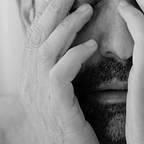Photo Haiku: More Moment Than Object
A brief breakdown of this idea in action
One of the aspects of photographic haiku that I’m always working on, and that gives students pause, is the balance between “moment” and “object.” While the things that catch my eye are very often cool looking (patterns, shadows, scenes), my haiku practice pushes me to capture images that are more than that. As a rule I suggest a haiku image couldn’t have been shot by another photographer nearby, nor even by me a moment before or after, and truly leverages the camera’s ability to show the ephemeral and fleeting. So here’s an example.
Yesterday I was on a plane. I love looking out the window and seeing landscapes from this perspective, or any assortment of amazing things once I get past my jaded adulthood, and instead embrace beginner’s mind. It’s not hard to fall into the wonder of sitting in a chair at 35,000 feet in the sky.
It was a nice moment: at sunset, the window on the plane surprisingly clean, the sky was clear, and we were just about to leave the Florida gulf coast and continue inland. For the next few minutes many little details were aligning, so I pulled out my camera.
There’s a lot to like in those initial shots — the golden hour light on the distant clouds, the dendritic patterns of the delta still visible in the shadows. One could make a case that this was a fleeting moment, and the picture satisfies that haiku principle. It doesn’t seem like an “object.”
But honestly, while I like how it’s not an “over the top” sunset… and there’s a moment of interesting discovery in the shadows—both important attributes of a photo haiku—it’s not particularly “poetic.” Some photographers would “improve” the visuals — maybe use a lot of post production to jack up the saturation in the sunset; or add some texture and contrast to spice up the ground. While I like the composition and many attributes, it’s still reasonably plain, there’s no dynamic. It’s almost a haiku, by my definitions, (or perhaps better to say “it’s a photo haiku, but not a strong one) but i’d say the crux of the problem is that its still too much landscape, too much “object.”
Then the woman in the seat ahead of me leaned forward to look out her window. And the sun illuminated her face in the space I could see. Suddenly everything changed. In that fraction of a second the scene shifted from “look at this interesting stuff out the window, isn’t it cool” to feeling like I saw a tableau laid out before me —the universal experience we all have had, looking out the window in wonder at the world below. Her fingers near her mouth accentuated that mood. I had an instant to recompose what I was seeing. I wanted to see her profile, but I also wanted to see what she was seeing.
This spontaneous shift pushed the scene into a “more-moment” zone. And, consequently, the photo ramped more solidly into a haiku, a tiny little scene I want to show, a short poem about human experience. The scene is unplanned, fully authentic. It’s an amazing confluence of fleeting elements — a “decisive moment” — now not only the rapidly changing land below and the setting sun, but her experience of it (and mine). The frame is highly composed, with everything in its place, balancing out the duel points of interest — first the scene out the window, then her face. And she’s not too lit, so you might not see her at first, which I like. It gives the image some rhythm — you see the bright sunset in the initial beat, and then you notice her. And it’s almost unnaturally simple. I felt enormous satisfaction the moment I pressed the shutter, the rush that makes photography fun. As quickly as I saw it, and shot it, she sat back, the sun went down, and the delta below disappeared.
Whether it’s a great photo haiku or not will take more time to determine. How will I feel about this in a month, or a year? Maybe it’s too “on the nose” and not letting the viewer do some interpretation. It’s simple, and so cleanly composed that it could be too perfect. Not enough wabi sabi. Maybe it’s too ordinary — it’s just someone looking out a window and even if this was fleeting, it’s really not that special.
There’s always the risk, even in the authentically captured moment, that it’s so shockingly clean that it feels set-up, even when it’s not. In a photo haiku, what actually happened isn’t as important as how it feels to the viewer. A good haiku has some grit to it, reality is required; and if it’s too clean, it can also fail.
So that’s what it looks like to create a photo haiku. If I hadn’t already been noticing the scene out the window I wouldn’t have had my camera out, and if I wasn’t already working the shot, I would have missed her leaning forward. This is why it’s important in the creation of haiku to be shooting “sketches” (the scene out the window) even if they might not be what you’re aiming for. The practice of noticing and composing is foundational, and only then are you ready when small moments occur.
Anyway, I thought it was a good illustration of the photographic work involved in photo haiku, and specifically of moving an image from object to moment, a key aspect of this form.
If this informs you, I encourage you to take one of my workshops through the Santa Fe Photographic Workshops. There are periodic 3-week online programs (6 sessions), and this August there is an in-person 1-week intensive that should be fun for any creative amateur, maybe if you’ve plateaued, feel like you’re good at picture taking, but want to push yourself. Anyway, Thanks for listening.
